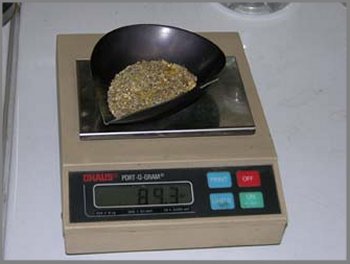![]()
By Ulf Dannenberg
When Carl moved from Southern California to Eureka (CA) and took on a maintenance job with Mobil Oil ten years ago, he never thought that one day he would become a gold miner. Actually, his wife Judy is to blame.
She told him that “There is Gold in those hills and rivers.” On weekends they went to the Trinity River, shovel and gold pan in hand, and started digging. The gold they found barely covered the bottom of a little glass vial, but Carl thought that they were doing pretty good. One Sunday they met a man working with a sluice box, and Carl thought, “Gee, what a neat device; you move a lot more material.” So he bought a sluice and found more gold. It seems that gold miners at an early stage have to go through the different steps of growing into the “business.” In other words, your equipment grows with your experience. Sure enough, a little later Carl met a man with a 2-inch dredge; and to Carl, that was an earth-moving machine. A 2-inch dredge was the next toy he bought, and the gold he found was better. Pretty soon he had his own claim and made a pennyweight a day. To improve his knowledge about mining he read Dave McCracken’s book on “Advanced Dredging Techniques.” Carl had a lot of questions and gave Dave a call. Dave at that time was just starting with The New 49’ers gold mining club. It didn’t take long to convince Carl that joining the club had a lot of advantages for him. He became a member. He worked his 2-inch dredge along the Klamath River, sticking to the side of the river in shallow waters all summer long. And, always going back to Eureka and his job on weekdays.
The next step in his mining experience was inevitable. He saw someone working a 5-inch dredge and said, “Wait a minute, there’s something wrong here. I have to have a 5-inch dredge.” Next thing, Carl was gone to buy one. He moved near the confluence of Tim’s Creek and the Klamath River on club claims, and found a virgin streak of overburden with shallow bedrock. Three and a half ounces! It was the largest amount of gold he had ever dredged up in one day. This was still part-time mining. Each weekend he and his wife Judy went home with at least an ounce of gold. When his boss put too much pressure on him, Carl felt it was time to take up dredging on a commercial scale. Subconsciously he’d known all the time that his future was in becoming a gold miner. He quit his job and moved to Happy Camp on a permanent basis. He could live easily off the gold he found and was quite happy.
One summer, however, was quite different. Not that he was running out of gold. Oh, no! But, Carl was running into all kinds of trouble. Carl became “famous” at the Saturday potlucks telling stories about his encounters with MURPHY’S LAW. These mishaps were quite funny to listen to, but only because of Carl’s unique way of telling these tales. He is definitely not the kind of guy who sheds tears over spilled milk. His kind of humor forbids that.
Here are two incidents told in his own words:
“I got here and was in a real hurry to get into the water. Found a nice spot on one of the new club claims and wanted to show this new guy how to put a dredge into the water. He had never seen this kind of operation before. I told him this is “a piece of cake”, I’ve done it many times. So, he just stood there watching us lowering the dredge down into this steep canyon. We had two safety ropes on the dredge, two guys on top of the road; Gordon and myself, guiding the rig down. Suddenly something snapped, I didn’t know what. And there it went! From zero to 60 in 6 seconds. I saw Gordon stepping away from the dredge and running away. One of the security ropes came whirling down the slope like an angry snake and nobody wanted to get caught by it. Finally the trailer with the dredge hit the bank at the end of the slope and tilted sideways.
claims and wanted to show this new guy how to put a dredge into the water. He had never seen this kind of operation before. I told him this is “a piece of cake”, I’ve done it many times. So, he just stood there watching us lowering the dredge down into this steep canyon. We had two safety ropes on the dredge, two guys on top of the road; Gordon and myself, guiding the rig down. Suddenly something snapped, I didn’t know what. And there it went! From zero to 60 in 6 seconds. I saw Gordon stepping away from the dredge and running away. One of the security ropes came whirling down the slope like an angry snake and nobody wanted to get caught by it. Finally the trailer with the dredge hit the bank at the end of the slope and tilted sideways.
The air compressor, gas tank and water pump all broke loose. When I got down there I couldn’t help myself. I started laughing out loud. It was a total disaster. We pulled the trailer with the dredge back up the hill and I had the dredge repaired for $280. The newcomer who watched us must have thought that we were a bunch of crazies. He had that kind of expression on his face.”
“A few weeks later I dredged with my partner Jerry just below Happy Camp. We wanted to move the dredge a bit downstream. I’m holding the dredge on a rope and my partner Jerry is out of sight behind the dredge, when all of a sudden the current caught the dredge and the safety line became tight like a guitar string. It started to slip through my fingers six inches at a time. I looked around. There was no place where I could tie the rope and I just couldn’t hold on much longer. So I let go of the rope and gripped the highline that was still attached to the dredge, and I managed to make it to shore with it. Two little bushes were all I could find to tie the rope around. But the dredge had put on speed and when the highline around the bushes tightened, SNAP! It ripped the bushes right out of the ground. The dredge was free to go and made it around the bend and out of sight.”
“Meanwhile, Jerry was standing on this large rock looking after the dredge like an Indian with one hand shading his eyes. I asked him what was going on, and he replied “It’s way down – now it stopped – no, wait a minute – it’s going again.” I knew then that I had to make it fast across the river to get to my car and drive after the dredge. Swimming through the current like Johnny Weissmuller, I barely made it to the other side and up the slope, got into Jerry’s car and drove after the dredge.”
“Every turn-out I stopped and looked. No dredge in sight. I drove on, and suddenly I saw something yellow. It was the dredge. I parked the car on the side of the road next to a Cal-Trans truck and got out. My heartbeat must have been up to 200. My knees were wobbly, I could hardly breathe, and thought I was close to a heart attack. I lay down on the road pavement to catch my breath and the driver of the Cal-Trans truck jumped out and came over to me. I was spreadeagled on the road. No breath, and my heart in my throat. So the guy asked me if he could help, if I needed something. All I could ask was, “Do you have a cigarette?” He said, “Yeah – need anything else?” So I croaked, “You got a light?” So he lights my cigarette and doesn’t know what the heck is going on. He looks over the side down towards the river and asked me if that is my dredge down there. “Yeah,” I said, “does it look alright?” He told me that my dredge was still swimming. When I finished smoking I got up and took a look. The dredge was stuck on a piece of bedrock right in the middle of the river surrounded by raging whitewater.”
“Something had to be done fast, before the current could rip it off the rock. I slid down the shale, slipping and falling through thorny bushes. I jumped into the water a hundred yards above the dredge and tried swimming across the river. I knew that if I missed the dredge I would be swept a mile downstream before I could make it up to the road again. I barely made it. I held on to a piece of bedrock next to the dredge. It took me quite a while to find a secure position and think things over. There was 600 feet of highline floating downstream in a fast current. I tell you, if you had dragged that line in, you’d know what you had done. It was a heck of a job to do. But I did it. By that time there was a crowd way up on the highway. Two Highway Patrol officers, two men from the Forest Service and also two guys from Cal-Trans. They really enjoyed the action and were applauding when I had the dredge secured. Now I looked for a spot where I could climb up the slope. I took my regulator and airline and looked for a deer trail, but all I could see was poison oak everywhere. I was in a bad mood. I could have kicked a bear’s butt and not worried about the consequences. I heard and saw rattlers on my way up through the poison oak, but I just didn’t care. Finally I made it to the top, but a few hundred yards away from the crowd. I had another cigarette and Jerry pulled up in his car. He was really scared about me. I asked him why and he said that the Highway Patrolmen thought I would kill myself, because the last thing they saw of me, was me disappearing into the bushes with a rope around my neck. Of course, the ‘rope’ was my airline and regulator and by no means was I going to kill myself over this accident. I laughed for a few minutes and it took away the tension.”
 Carl works his new 6-inch dredge with great success making between three-quarters and one ounce a day. He works all summer and goes back to Eureka for the winter where he goes metal detecting along the beaches. When you happen to meet him, ask him about the many other MURPHY stories he has experienced. He will tell you in detail, and laugh about it.
Carl works his new 6-inch dredge with great success making between three-quarters and one ounce a day. He works all summer and goes back to Eureka for the winter where he goes metal detecting along the beaches. When you happen to meet him, ask him about the many other MURPHY stories he has experienced. He will tell you in detail, and laugh about it.



 dredgers and saw the gold they recovered and I just had to have one of those machines.”
dredgers and saw the gold they recovered and I just had to have one of those machines.” Now it’s 1990 and they’re back. They have a better dredge, better accommodation in a bachelor apartment, met all their friends from last year, and have a good spot in the river to work.
Now it’s 1990 and they’re back. They have a better dredge, better accommodation in a bachelor apartment, met all their friends from last year, and have a good spot in the river to work.



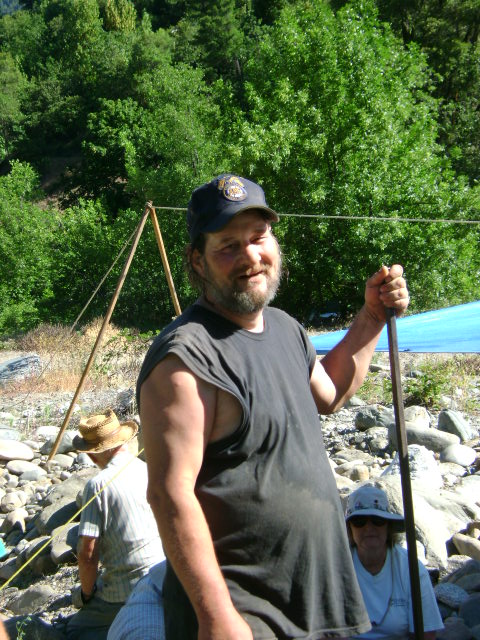 Over the years, I have discovered that every single group is different. It is something about how the combined social chemistry comes together. This all gels during introductions on the first morning. Some groups are more enthusiastic than others.
Over the years, I have discovered that every single group is different. It is something about how the combined social chemistry comes together. This all gels during introductions on the first morning. Some groups are more enthusiastic than others.  Another of the first things we do once out in the field, is to show everyone what hard-pack streambeds are, what the different layers look like, and exactly where we have been
Another of the first things we do once out in the field, is to show everyone what hard-pack streambeds are, what the different layers look like, and exactly where we have been  Since there are always beginners present, I also provide a
Since there are always beginners present, I also provide a 

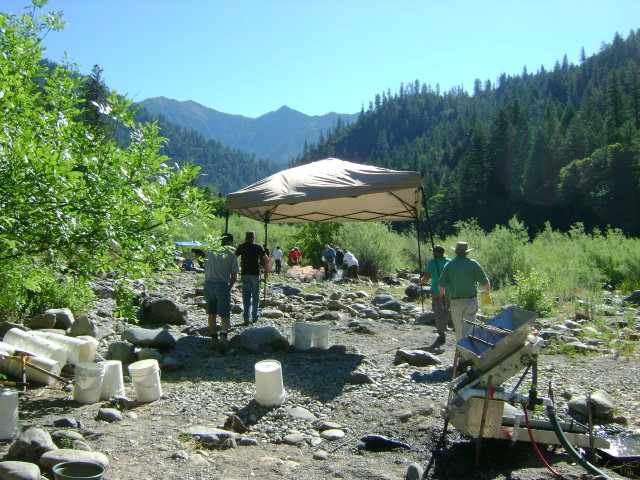 smoothly. Here are three video segments which captured some of the action:
smoothly. Here are three video segments which captured some of the action:
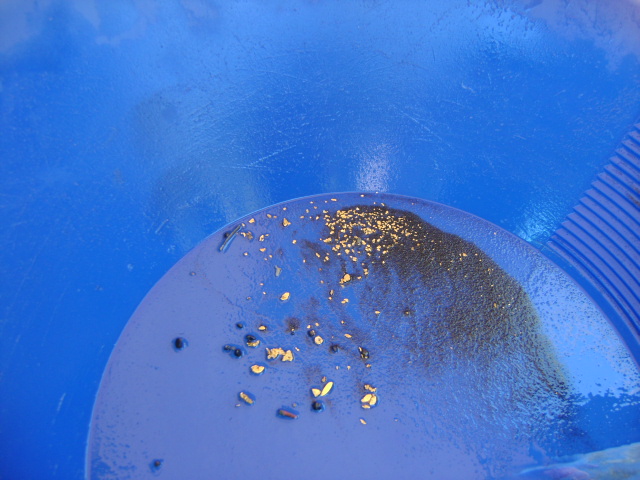




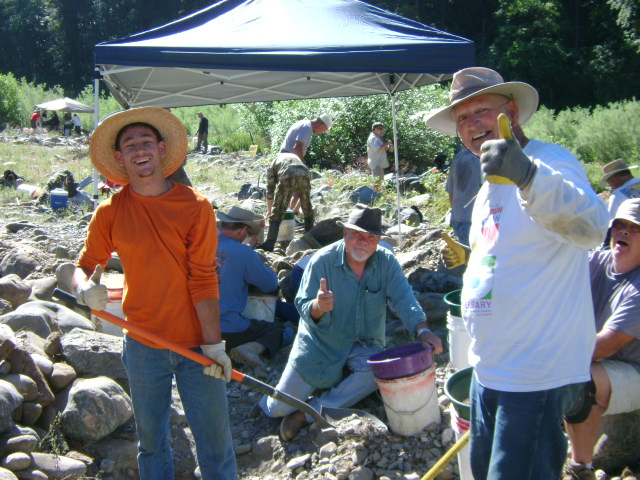






 It turned out that I was right about that. I found the orange-colored hard-pack as soon as I started dredging material into the 4-inch nozzle. I reached bedrock within just a short time. The material was less than a foot deep. Easy!
It turned out that I was right about that. I found the orange-colored hard-pack as soon as I started dredging material into the 4-inch nozzle. I reached bedrock within just a short time. The material was less than a foot deep. Easy! were experiencing when we performed the first clean-up on the dredge:
were experiencing when we performed the first clean-up on the dredge: Other members have established a completely separate line of gold on the access-side of the river, and another line out in the middle of the river. I gather the reason there is more than one gold line is that there are multiple sources of gold entering the river just upstream. One of our members working the access-side of the river showed me a bottle of beautiful nuggets which even has me rethinking the plans for where I will operate my 5-inch dredge!
Other members have established a completely separate line of gold on the access-side of the river, and another line out in the middle of the river. I gather the reason there is more than one gold line is that there are multiple sources of gold entering the river just upstream. One of our members working the access-side of the river showed me a bottle of beautiful nuggets which even has me rethinking the plans for where I will operate my 5-inch dredge!



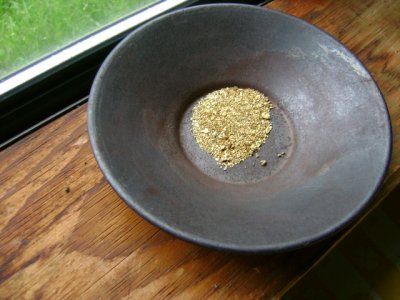
 Then, even before we finished the first gold line, maybe two seasons ago, someone discovered an entirely new line of high-grade gold that ran the entire length of the bar perhaps 30 feet further inland from the first line of gold. That is the line of gold that we were mining all last season. As this second line had not been worked very much towards the upper-end of the bar, my plan has been to focus our high-banking projects up that way this summer. There is still
Then, even before we finished the first gold line, maybe two seasons ago, someone discovered an entirely new line of high-grade gold that ran the entire length of the bar perhaps 30 feet further inland from the first line of gold. That is the line of gold that we were mining all last season. As this second line had not been worked very much towards the upper-end of the bar, my plan has been to focus our high-banking projects up that way this summer. There is still 






 And that’s the way it was on this Saturday afternoon as soon as our participants began digging a little further inland. They started coming up with good pans right away. At first, I thought it was just an anomaly; perhaps a little gold located off the main line. Then, others started recovering the same kind of gold. The average pieces were larger than from the earlier line that we had established down closer to the river. Wow, this was a real bonus!
And that’s the way it was on this Saturday afternoon as soon as our participants began digging a little further inland. They started coming up with good pans right away. At first, I thought it was just an anomaly; perhaps a little gold located off the main line. Then, others started recovering the same kind of gold. The average pieces were larger than from the earlier line that we had established down closer to the river. Wow, this was a real bonus!

 This new pay-streak is positioned along the bottom of a top layer of hard-packed streambed, which is sitting on top of a really hard layer of dark brown material. Sometimes, the lower layer looks like dirt. It is
This new pay-streak is positioned along the bottom of a top layer of hard-packed streambed, which is sitting on top of a really hard layer of dark brown material. Sometimes, the lower layer looks like dirt. It is  The depth of the pay layer also makes a difference in how much gold you need to see in your pan when sampling. The deeper that you have to dig, the richer the pay-dirt must be to make a mining program pay off to your satisfaction. Finding this whole new line of gold on K-15A was truly a stroke of luck. Here follows a video segment capturing my own explanation as all the action was happening:
The depth of the pay layer also makes a difference in how much gold you need to see in your pan when sampling. The deeper that you have to dig, the richer the pay-dirt must be to make a mining program pay off to your satisfaction. Finding this whole new line of gold on K-15A was truly a stroke of luck. Here follows a video segment capturing my own explanation as all the action was happening: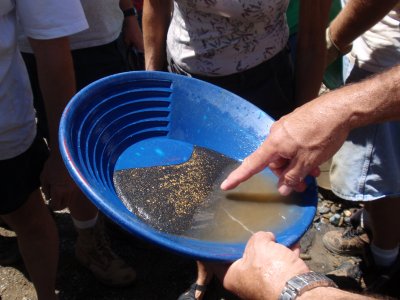
 In all, we recovered 16.4 pennyweights of gold. That is more than ¾ of an ounce, or $1,000 at the current gold price. There were 14 nuggets. This is pretty good considering that we operated three high-bankers for several hours. Here follows Rich Krimm’s introduction to the final clean-up and gold split. We had a lot of fun. Check it out:
In all, we recovered 16.4 pennyweights of gold. That is more than ¾ of an ounce, or $1,000 at the current gold price. There were 14 nuggets. This is pretty good considering that we operated three high-bankers for several hours. Here follows Rich Krimm’s introduction to the final clean-up and gold split. We had a lot of fun. Check it out:

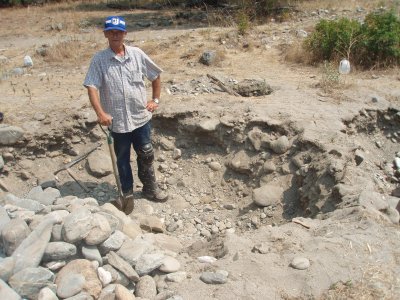 Both Clarence and Cindy are from the country. Cindy grew up on a dairy farm in Oregon where she was born. She says. “The farm was a lot of physical work and definitely kept me in shape. That kind of living helped prepare me for the mining that we continue to do now.” Clarence ran a sheep and cattle ranch in Idaho, and also a dairy. So he is also very familiar with hard physical work.
Both Clarence and Cindy are from the country. Cindy grew up on a dairy farm in Oregon where she was born. She says. “The farm was a lot of physical work and definitely kept me in shape. That kind of living helped prepare me for the mining that we continue to do now.” Clarence ran a sheep and cattle ranch in Idaho, and also a dairy. So he is also very familiar with hard physical work.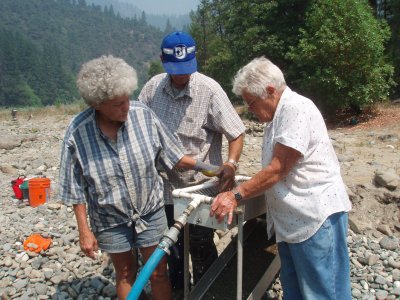 Even Cindy”s mom, Adelma, (who is 78 years old) has joined them. She says that being outside and active has helped keep her feeling young.
Even Cindy”s mom, Adelma, (who is 78 years old) has joined them. She says that being outside and active has helped keep her feeling young.




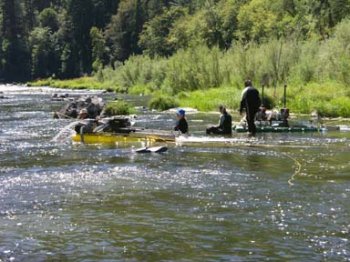
 Even though the project took place over a year ago, the story and video segments go a long way to show the camaraderie and great adventures our
Even though the project took place over a year ago, the story and video segments go a long way to show the camaraderie and great adventures our 
 While most of us
While most of us 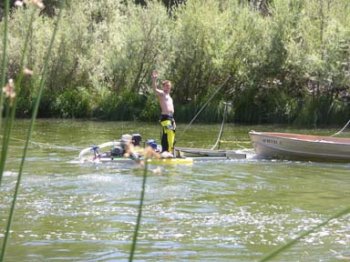


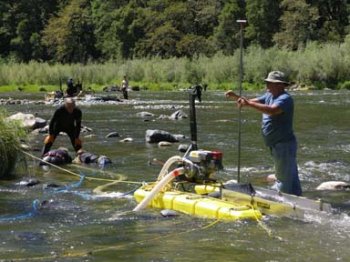



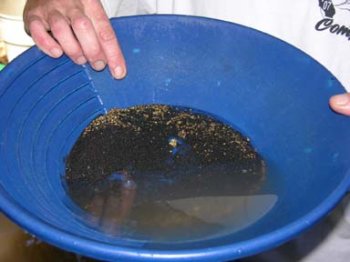
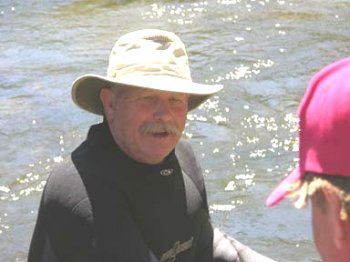


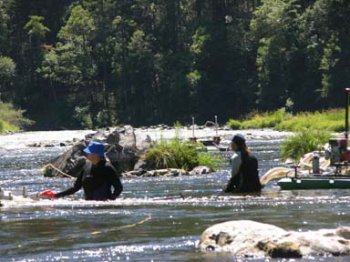

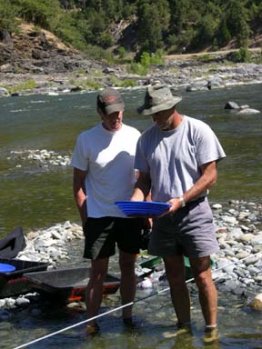
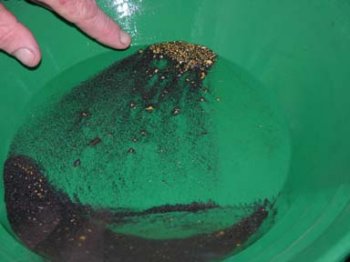



 Still, as usual, most of the excitement was taking place on the beginner-dredge. There, it seemed like every few minutes, they were passing up more gold nuggets that they were digging out of the bedrock. I swear, there were times the whole bunch of them were jumping up and down, yelling. Several times, I thought the more serious dredges were going to shut down just to go over and see what all the yelling was about!
Still, as usual, most of the excitement was taking place on the beginner-dredge. There, it seemed like every few minutes, they were passing up more gold nuggets that they were digging out of the bedrock. I swear, there were times the whole bunch of them were jumping up and down, yelling. Several times, I thought the more serious dredges were going to shut down just to go over and see what all the yelling was about!



